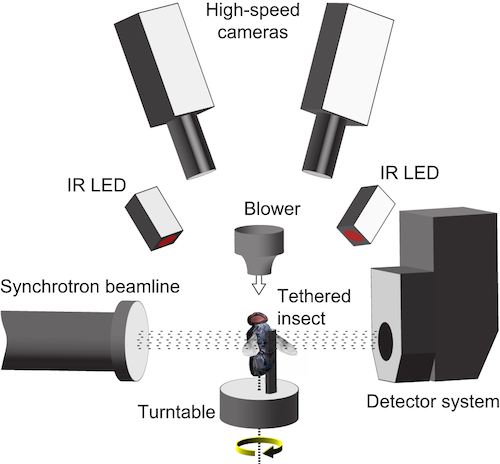 Evolution
Evolution
 Intelligent Design
Intelligent Design
Insect Flight Comes to Light with 3D Imaging in X-Rays

European scientists have pulled off an imaging coup: Using high-energy X-rays, they produced 3D motion videos of the flight muscles of a blowfly. By attaching the living fly to a mount and gently blowing air toward it to get it to flap its wings, while irradiated in X-rays, the team obtained a sequence of images that resolve the tiny muscles in action from multiple directions. The resulting images allow us to view the flight and steering mechanisms of an insect in action. It’s like lifting the panels and peering into the operating motors of an aircraft engine. With this new knowledge, engineers are learning things that may help them design micro flying machines.
If you’ve seen Flight: The Genius of Birds, you probably remember the 3D animations of avian flight muscles and bones in operation. Hummingbirds can beat their wings over 100 times per second. This blowfly matches that with 145 Hz wingbeats, using much smaller equipment packed into a thorax only 4mm in length. Some of the steering muscles are as small as a human hair.
Reporting their research in PLOS Biology, the authors describe the engineering marvels of insect flight with the words extreme, dramatic, complexity, and intricate:
Insects are the smallest and most agile of all flying animals. These attributes are taken to extremes in the dipteran flies, whose single pair of wings enable a range of dramatic flight manoeuvres, from turning on the spot, or flying backwards, to even landing on ceilings. The blowfly Calliphora vicina routinely pulls up to four times its body weight during turns, and its seemingly simple reciprocal wingbeat belies the complexity of the flight motor that drives it. Each of the two wings is powered by four stretch-activated muscles that undergo self-induced oscillations at a frequency in excess of 100 Hz. Rather than attaching directly to the wings, these indirect power muscles drive small amplitude deformations of the thorax, which are then amplified through the intricate wing hinge. (Emphasis added.)
There’s more. The fly’s wing uses “arguably the most complex joint in nature.” The wingbeat is “50 times faster than the blink of an eye.” Thirteen pairs of steering muscles, “specialized to absorb mechanical energy,” represent less than 3 percent of the fly’s already tiny mass. The authors are obviously excited about studying “this remarkable mechanism.”
It’s enough to make you feel guilty for trying to swat one of these creatures — which is easier said than done, of course. Who would have thought that flies are masters of physics, including dynamics, energetics, and materials:
Our visualizations show that the steering muscles operate through a diverse range of nonlinear mechanisms, revealing several unexpected features that could not have been identified using any other technique. The tendons of some steering muscles buckle on every wingbeat to accommodate high amplitude movements of the wing hinge. Other steering muscles absorb kinetic energy from an oscillating control linkage, which rotates at low wingbeat amplitude but translates at high wingbeat amplitude. Kinetic energy is distributed differently in these two modes of oscillation, which may play a role in asymmetric power management during flight control. Structural flexibility is known to be important to the aerodynamic efficiency of insect wings, and to the function of their indirect power muscles. We show that it is integral also to the operation of the steering muscles, and so to the functional flexibility of the insect flight motor.
In the conclusion, they add: “The fast, complex, three-dimensional movements of the insect flight motor are powered and controlled by several tens of linear actuators, each individually producing only a low-amplitude contractile strain.”
The scientists did not refer to evolution at all. In another paper in PLOS Biology, Anders Hedenstr�m of Lund University in Sweden shares the excitement of the discoveries, but decided to throw in a little comment perhaps to appease the Darwin police: “The ability for powered flight has evolved four times in the animal kingdom and, thanks to their ability to fly, insects have diversified and moved into new regions and habitats with enormous success.” Hedenstr�m goes on to say:
The ability of a fly to accelerate, make tight turns, rolls, and loops that allow the creature to land upside down on a ceiling is unparalleled in any other organisms, as well as any manmade aircraft. Everybody knows how difficult it is to swat a fly with bare hands — the fly’s capacity for rapid take-off and accurate movement away from a perceived approaching threat is exquisite.
It almost seems some scientists consider it a necessary evil, like paying taxes, to mention evolution at least once when they wax eloquent about design in nature. After all, the authorities are watching and reading. So be it for now. The evidence for design should have an effect on the power structure in due time.
Meanwhile, Hedenstr�m enthuses about mining further studies of insect flight for design ideas. Wouldn’t it be great to do imaging of untethered, free flight during those rolls and loops?
Furthermore, a more complete understanding of the flight muscle-hinge mechanism may help bio-inspired design of wing articulation systems for fly-like micro air vehicles. Until then, we can enjoy the stunning videos of the oscillating thorax and flight muscle system of the blowfly.
Has the Darwinian approach, in seeking to explain away the brilliance of such designs in nature, brought anyone any similar joy lately? Just asking.
